
The pineapple is a tropical plant with an edible fruit; it is the most economically significant plant in the family Bromeliaceae.
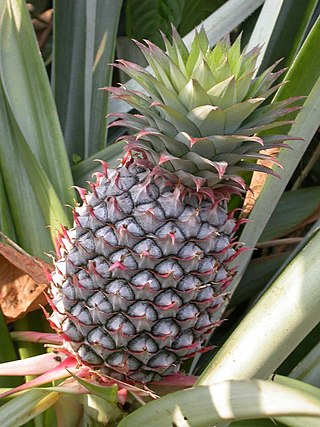
The Bromeliaceae are a family of monocot flowering plants of about 80 genera and 3700 known species, native mainly to the tropical Americas, with several species found in the American subtropics and one in tropical west Africa, Pitcairnia feliciana.

Tillandsia is a genus of around 650 species of evergreen, perennial flowering plants in the family Bromeliaceae, native to the forests, mountains and deserts of the Neotropics, from northern Mexico and the southeastern United States to Mesoamerica and the Caribbean to central Argentina. Their leaves, more or less silvery in color, are covered with specialized cells (trichomes) capable of rapidly absorbing water that gathers on them.
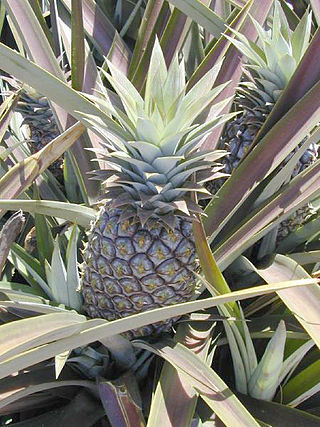
Ananas is a plant genus in the family Bromeliaceae. It is native to South America. The genus contains Ananas comosus, the pineapple.

Pandanus is a genus of monocots with about 578 accepted species. They are palm-like, dioecious trees and shrubs native to the Old World tropics and subtropics. Common names include pandan, screw palm and screw pine. They are classified in the order Pandanales, family Pandanaceae.

The Marie Selby Botanical Gardens is a 15-acre (6.1 ha) botanical garden located at 900 South Palm Avenue in Sarasota, Florida. The Gardens are located on the grounds of the former home of Marie and William Selby. The Gardens acquired the Historic Spanish Point campus on May 1, 2020.

Pandanus tectorius is a species of Pandanus (screwpine) that is native to Malesia, Papuasia, eastern Australia, and the Pacific Islands. It grows in the coastal lowlands typically near the edge of the ocean. Common names in English include thatch screwpine, Tahitian screwpine, hala tree and pandanus. The fruit is edible and sometimes known as hala fruit.

Guzmania is a genus of over 120 species of flowering plants in the botanical family Bromeliaceae, subfamily Tillandsioideae. They are mainly stemless, evergreen, epiphytic perennials native to Brazil, southern Mexico, Central America, and northern and western South America. They are found at altitudes of up to 3,500 m (11,483 ft) in the Andean rainforests.

Puya raimondii, also known as the Queen of the Andes (English), titanka and ilakuash (Quechua) or puya de Raimondi (Spanish), is the largest species of bromeliad, its inflorescences reaching up to 15 m (50 ft) in height. It is native to the high Andes of Bolivia and Peru.
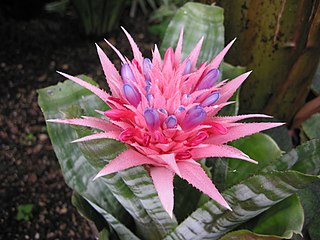
Aechmea fasciata is a species of flowering plant in the Bromeliaceae family. It is commonly called the silver vase or urn plant and is native to Brazil. This plant is probably the best known species in this genus, and it is often grown as a houseplant in temperate areas.

Pandanus utilis, the common screwpine is, despite its name, a monocot and not a pine. It is native to Madagascar and naturalised in Mauritius and the Seychelles.

Bromelioideae is a subfamily of the bromeliads (Bromeliaceae). This subfamily is the most diverse in the family, represented by the greatest number of genera with about 40. Most of the plants in this group are epiphytes, though some have evolved in, or will adapt to, terrestrial conditions. This subfamily features the most plant types which are commonly cultivated by people, including the pineapple.
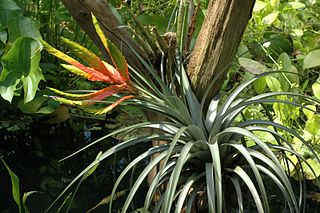
Tillandsioideae is a subfamily of plants in the bromeliad family Bromeliaceae. This subfamily contains the greatest number of species. Most are epiphytic or lithophytic, growing in trees or on rocks where they absorb water and nutrients from the air. Spanish moss of the genus Tillandsia is a well-known species. Bromeliads in the genera Guzmania and Vriesea are the more commonly cultivated members of this subfamily.

Fascicularia is a monotypic genus of flowering plants in the pineapple family Bromeliaceae, subfamily Bromelioideae. The genus name is from the Latin fasciculus (bundle) and arius.

Portea is a genus in the plant family Bromeliaceae, subfamily Bromelioideae. It is native to the Atlantic coast of Brazil.

The Botanischer Garten der Technischen Universität Dresden, also known as the Botanischer Garten Dresden or Dresden Botanical Garden, is a botanical garden maintained by the Dresden University of Technology. It is located in the north-west section of the Großer Garten at Stübelallee 2, Dresden, Saxony, Germany. It is open daily without charge.
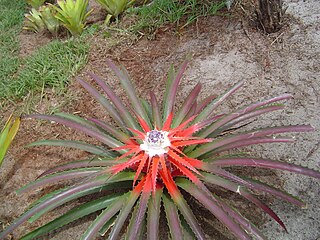
Bromelia balansae is a plant species in the genus Bromelia. This species is native to Argentina, Brazil, Colombia, Bolivia, and Paraguay where it grows at elevations of 150 to 3,000 feet.
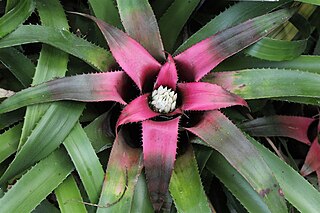
Hylaeaicum is a genus of flowering plant in the family Bromeliaceae, native to tropical northern South America. The taxon was first described by Ernst Heinrich Georg Ule in 1935 as a subgenus of "Aregelia". It was later treated as a subgenus of Neoregelia, before being raised to a full genus in 2021, a status accepted by both Plants of the World Online and the Encyclopaedia of Bromeliads.
Pandanus kaida is a monocot species of plant in the family Pandanaceae, known only in cultivation. It is native to India, Sri Lanka. Provided the appearance of its fruit, the species is sometimes referred to as the false pineapple, despite not belonging to the pineapple genus.
Elton Martinez Carvalho Leme is a Brazilian who is employed as a judge. He is also a self-taught botanist with a special interest in bromeliads. As of November 2022, the International Plant Names Index listed 629 scientific names which include Leme as a publishing author, including 13 generic names.



















